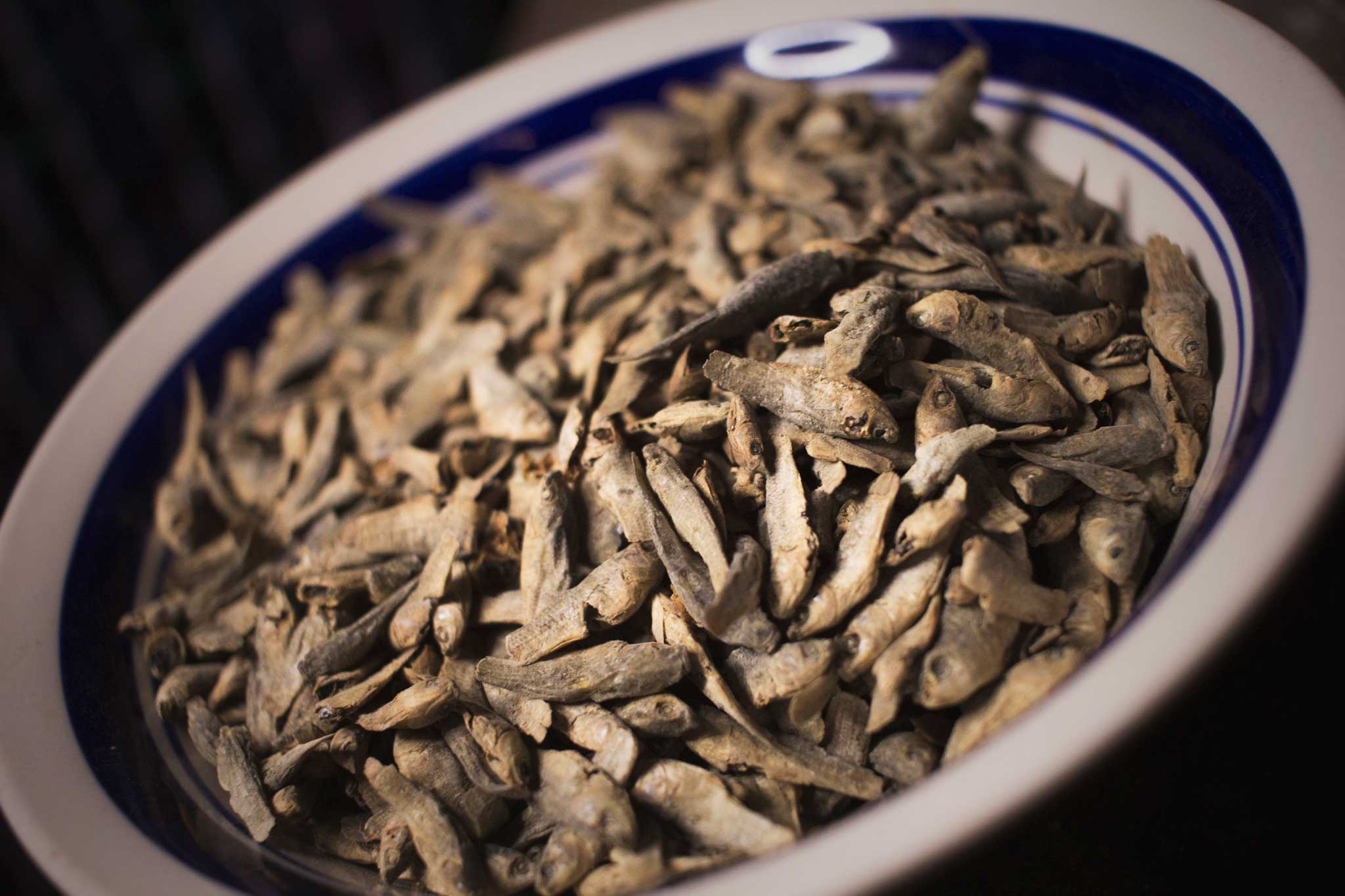Manjúa: a small fish of great importance in Guatemala
Manjúa is vital to the food security of Indigenous populations in Guatemala – to ensure it can continue to sustain future generations, sustainable fishing regulations should be prioritized.
Zoila De La Cruz is a fisherwoman of Mayan Q’eqchi’ origin, whose strict daily routine varies only according to the weather at dawn in Río Salado, the village of Lívingston, Izabal, in northeastern Guatemala, where she lives. Every morning, before the first rays of daylight, she and her children prepare to sail the waters of the Bay of Amatique in search of manjúa.
In this bay, which Guatemala shares with Belize, also live the Garifuna, another of the four major ethnic groups, along with the mestizos, Mayas and Xincas, that make up the Guatemalan population. And it is from the Garífuna language, or Garinagu, that the word manjúa, which means sardine, comes from. Likewise, it is in this bay where four of the six species of this small fish are harvested: manjúa negra (Anchoa lyolepis), manjúa canche (Anchoa clupeoides), manjúa campechana (Brevoortia patronus) and manjúa panzona (Cetengraulis edentulus), explains Manuel Ixquiac, in charge of monitoring and evaluation of fishery resources for the Regional Coastal Biodiversity Project of the International Union for Conservation of Nature (IUCN).
Sardines, anchovies and anchovetas, which live in coastal areas and form dense schools, reach maximum sizes of 15 centimeters, depending on the species, and serve as food for many other species, some of which, like the European bass (Dicentrarchus labrax) and the Red porgy (Pagrus pagrus), are commercially important for the region. Because of their role in the marine life trophic chain, this fishery is prohibited in all Central American countries.
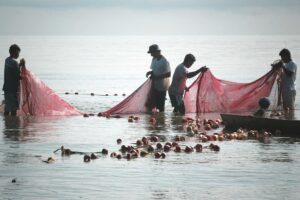
Many of the manjúa fishermen belong to the Maya Q’eqchi’ indigenous community, and rely on this fishery as their only source of income. Photo: Emerson Díaz
However, in Guatemala, unlike other countries in the region, it continues to be fished because of its socioeconomic and cultural value. Not only is it the only source of income for Zoila, as well as for another 250 families distributed between Lívingston, Puerto Barrios and Punta de Manabique, all in the department (or district) of Izabal, but it also serves as a food and nutritional base for the K’iche’, K’aqchiquel’, Mam and Tzu’tujil Mayan people living in the center of the country, known as the Guatemalan Highlands.
“The interesting thing about the manjúa is its socioeconomic importance, because it is a species that guarantees or sustains food security,” said Ixquiac . Sardine meat is rich in essential fats and oils, such as omega-3 and omega-6. “These polyunsaturated fats, called good or healthy fats, lower the levels of certain lipoproteins that are directly associated with the risk of cardiovascular disease,” according to the report La pesca de la Manjúa en el Caribe de Guatemala, published by the National Secretariat of Science and Technology (SENACYT) in 2008.
The same report states that 100 grams of manjúa provides more animal protein than pork, chicken or beef. It is a key food for areas such as Sololá and the rest of the Guatemalan Altiplano, where some of the regions with the lowest human development indexes (HDI) are located, according to the United Nations Development Program. Sololá, for example, is the seventh department, out of 23, with the lowest HDI, with 0.455, compared to 0.66 for Guatemala as a country.
This means that, according to the Multidimensional Poverty Index of Guatemala (IPM-Gt), 61,6% of the population of the country (16,3 million) survive with less than $3,68 a day. Of that percentage, almost 30% live in extreme poverty, which means that they get by with $2,07 per day. Because of this, the majority of people in Guatemala do not have the opportunity to access the basic market basket;this is why the consumption of the manjúa is so important for them.
Because of its importance to the economic, social and cultural development of the country, the manjúa fishing activity should be one of the most regulated and protected by the State. “It has closed periods, no-fishing zones, minimum catch size, and specific regulations on the characteristics of the fishing gear. But, one thing is that these regulations exist, and another that they are complied with,” lamented Ixquiac.
Where is the manjúa marketed?
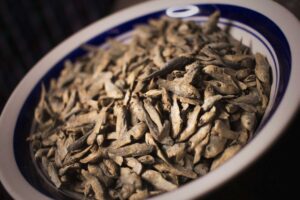
Manjúa, sardina, pepesca, pupos or pescaditos are the names given to several species of anchovies and anchovetas fished in the Caribbean waters of Guatemala. Photo: Jorge Rodríguez
“We have no idea where they take it. Only the buyer comes, we negotiate a price and sell it. We just fish it and that’s it,” said Zoila when asked if she knows the destination of the manjúa she extracts from the sea. For sure, the only thing she thinks about is the money she will get from her daily catch.
After catching it, Zoila and the other fishermen, also known as sardineros, salt the manjúa on the spot. This is important because it helps the fish release moisture. Then, on land, the process is finished by drying it in the sun. After that, they stack it up in plastic bags for the seller to collect.
Depending on the time of year, the price offered by the middleman for a pound of manjúa varies from 1 ($0.13) to 8 quetzales ($1.03). The average is Q5 ($0.64). However, after being distributed in different markets, the same pound can be purchased for more than Q20 ($2.60). Even though the final price is not cheap, a pound of chicken, for instance, is worth Q11 ($1,42) and of meat Q28 ($3,63), people tend to buy by the ounce, which can feed the whole family, as opposed to others type of meat.
Its amazing nutritional profile and wide appeal have caught the attention of dealers from El Salvador. “We pack it in trays of one or three pounds, and export it,” said Leider Pérez, fisherman and manjúa seller in Puerto Barrios. However, Guatemala is still the only place where its capture is legal.
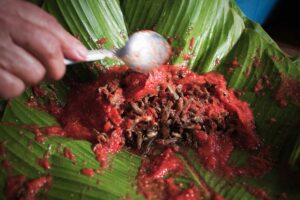
P’aay chú s’aay (patín de pescaditos in Maya Tzu’tujil), made with manjúa, is a traditional ancestral dish from the Lake Atitlán area. Photo: Jorge Rodríguez
Most of the manjúa, which in other regions of the country is known as pepesca or simply as pescaditos, is taken to Guatemala City and then distributed to markets in Chimaltenango and El Quiché, departments located some 60 and 150 kilometers west of Guatemala City, respectively. From there, it is moved to other departments such as Sololá, Quetzaltenango and Huehuetenango, which have a majority indigenous population. There, “the people throw it on the comal, brown it, and eat it toasted, with a little tomato, a little lemon. It’s delicious,” said Leider Pérez, fisherman and manjúa seller in Puerto Barrios.
In Sololá, specifically in San Pedro La Laguna, on the shores of Lake Atitlán, Catalina Ajqú uses manjúa to prepare P’aay chú s’aay (fish skate, in the Maya Tzu’tujil language). Like Zoila, Doña Catalina does not know where she gets the dried fish she uses to make the patín. “We prepare it on any occasion to share with the family, or for our husbands when they go to the countryside,” she said. And it’s not just a homemade preparation. Patín can be purchased at the local market in San Pedro, and can also be made with dried shrimp, chicken and pork.
Unregulated fishing
“Manjúa fishing began about 50 years ago. Some countrymen named Cotoc were the ones who bought it and took it to the interior of the country,” recalled César Aguilar, a fisherman in his 70s. The interest of these highlands merchants created a new niche that didn’t exist before the 1970s. Aguilar was part of one of seven crews that began extracting manjúa in the shallow waters of Punta de Manabique.
Now, it is estimated that currently there could be around 600 registered fishermen dedicated to manjúa extraction, and one of the biggest efforts is to have a proper census, so the Department of Fisheries and Aquaculture Regulations (DIPESCA) of the Ministry of Agriculture and Livestock (MAGA), could apply different regulations, in order to reorganize the activity for the benefit of both the community and the region’s marine biodiversity.
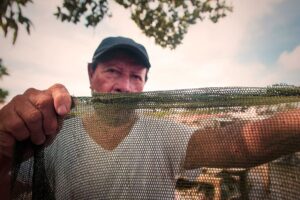
César Aguilar, one of the “original sardineros”, shows a typical net for mangrove fishing, whose mesh size endangers the survival of up to 60 other species that inhabit the mangrove. Photo: Jorge Rodríguez
It is here where this collaborative effort between different sectors seeks to have a real impact. By knowing how many people fishes for the manjúa, and how much they extract, more effective strategies to protect the availability of this natural resource, without affecting the people’s means of life, could be created. However, the current reality it’s conditioned by the lack of control established since the inception of the activity, this according to Manuel Ixquiac.
“It wasn’t until 1998-99, when the Mesoamerican Reef System (MAR) was recognized as an area of great importance for the region’s fisheries, that the countries of the region expressed an interest inGuatemala abandoning the manjúa fishery,” said Ixquiac.
Surprisingly, despite all of this, there is still no danger to the biological equilibrium, at least from the perspective of the sardineros, because even though right now the fish stocks are “a bit overexploited”, according to Ixquiac, the availability of the resource is still abundant. Estimates speak of an annual extraction of 2,700 metric tons of manjúa. Other studies made by DIPESCA, found out that annual biomass has increased “from 40 tons in 2006, to 48 and 52 in the recent years,” said Mario Salazar, Inspector of fisheries atthe government entity.
Shared responsibilities
So, why all of these efforts are important? Everyone involved seeks fair conditions for themselves. The authorities aspire to have an orderly and regulated activity, that benefits fishermen and those who consume the manjúa. The sardineros want fair working conditions, since this is the only job they have. Lastly, the international organizations, like IUCN, promote sustainable management that benefits communities and marine life of the region.
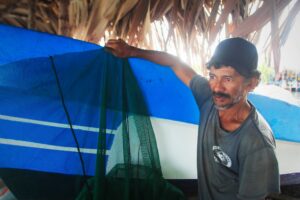
Benedicto Cordón is a fisherman from Puerto Barrios who is actively working to improve the living conditions of the fishermen of Puerto Barrios and the management of fish stocks in the bay. Photo: Jorge Rodríguez
In that matter, one of the strongest features of the conservation strategy is the fishing ban, that goes from May 1 to July 15. Every year, Zoila and the rest of sardineros must seek other economic activities, to allow the juvenile manjúas to reach their ideal measurement. “DIPESCA, annually, comes to enforce the ban, through meetings with representatives of each fishing community,” said IUCN’s Blanca García, coordinator of the biodiversity program. Up to 120 fishermen participate in these meetings, so the no-fishing periods are adopted in a participatory, consensual manner.
The problem is that, during this period, many of these fishermen cannot resort to other types of productive activities for their subsistence. Unlike other populations in Guatemala, the residents of this part of the country do not have land to grow crops for their own consumption. “In each closed season, the fishermen’s committee in each village asks the municipality for help (a bag of food). Sometimes they give it, and sometimes they don’t,” lamented Zoila.
This lack of opportunities, as well as the weakness of DIPESCA to carry out surveillance trips, leads many of the fishermen to violate the ban. “For us, the way to solve this problem is with a strongerpresence of the fishing authorities,” said Benedicto Cordón, sardine fisherman and representative of the Puerto Barrios fishermen’s committee.
Although DIPESCA recognizes that the lack of funds is a major impediment to carrying out an “effective management” of compliance with the ban, they believe that it is the fishermen who must do more on their part to prevent the reduction of the fishing resource. “If we say to the fisherman “try to limit the manjúa these months”, it is because we know that the manjúa is reproducing. Many of the fishermen are not aware of that, but the long-term closure is beneficial for everyone,” commented Salazar. “”If the department of fisheries (MAGA) does not have more authority to apply the law, the most likely thing is that those who violate the law, will continue breaking it,” replied Cordón.
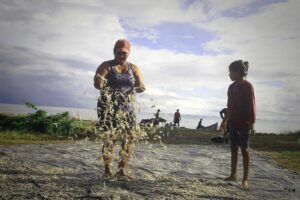
At the end of the fishing day, each sardinero unloads the product, already salted, and spreads it on a piece of black plastic to dry it in the sun, and then put it on sale. Photo: Jorge Rodríguez
However, blaming only the sardine fishermen for fishing during the closed season is not the best strategy to find a solution to this problem. Most of them do it because they have no alternative to bring income to their households. “We would work on other things, if there were [options], but, for the moment, we don’t have any other opportunity other than just fishing,” said Zoila.
Only in Punta de Manabique, a protected area administered by the National Council of Protected Areas (CONAP), are some alternative activities to fishing contemplated, such as charcoal extraction, forest resource management and cattle ranching. According to Sergio Hernández, a CONAP technician, in addition to the permits for resource extraction (fishing, coal and timber extraction), the entity works with community members to also prevent overexploitation of these natural resources.
“We know that if the population is not made aware, they will not use their resources sustainably. Twice a month we carry out sensitizations with community leaders to involve them in conservation processes,” he said.
Along the same lines, IUCN, through the Coastal Biodiversity Project, allocated economic resources to strengthen the network of fishermen in the bay area. “The aim is to provide economic alternatives for the sustainable management of fishery resources,” said Blanca García, project coordinator. “The organized fishermen’s desire is to build a storage center with cold rooms, to be able to store the product, set fixed prices for the whole year and thus be able to have income even during the closed season,” she added. This storage center will serve for all the fisheries, like lobster or shrimp, that take place in the area.
Towards a sustainable fishery
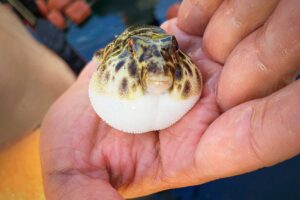
The use of non-permitted fishing gear to catch manjúa puts other species at risk: puffer fish, seahorses and other marine animals, among others, which end up as bycatch. Photo: Ángeles Shoenbeck
Although it is true that the weakness of the state is manifested in its limited capacity to monitor the actions of fishermen, and that there are no economic alternatives that sardineros can do while the ban is in force, it is also true that the fishing net they use, is a threat to other marine species. “It is a mosquito net (with mesh sizes from 2 mm to ¾ cm) that only allows water to pass through,” acknowledged Ixquiac. Of the 2,700 metric tons of manjúa harvested annually, 10% of it is bycatch (ballon fishes, sea horses and other fishes of commercial value in juvenile stages)
Alongside IUCN’s biodiversity program, Ixquiac is currently working with the fishermen to encourage the use of a net with a 5 mm mesh size. While this comes into practice, like all of the other efforts made up until now, the only recourse is to rely in the good faith of the sardineros to respect the current regulations.
“Now, the most important route of work is precisely the management of the accompanying fauna of manjúa. The fishermen must separate them and leave the greatest amount of species that return alive to the sea after fishing. This is an agreement that must be reached as soon as possible,” urged Ixquiac.
The other major role of this story belongs to the Guatemala’s government, as they have to realize that, in order for all of this to work, they have to increase the budget of DIPESCA, to run more surveillance trips, to ensure that no one is breaking the law, and to seek ways in which the fishing communities can generate income while the ban is in force.
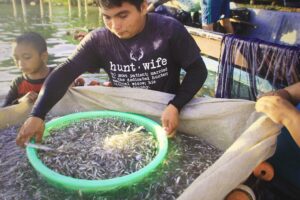
Manjúa fishing is a family fishery, in which fishermen, from young children to grandparents and older adults participate. Photo: Jorge Rodríguez
“We see the need to strengthen the capacities of DIPESCA. We also see that one of its weaknesses is in surveillance, so that is why we promote participatory local management processes, where work agreements are generated with fishermen for the promotion and compliance of fisheries regulations,” said Blanca Garcia of IUCN. She also stated that they are confident that all of these new processes they are working with the biodiversity program, will result in legal mandates agreed with all the sectors involved, and will be added to the regulations now in force.
While the efforts of all the sectors involved manage to settle down, Zoila will continue with her routine in search of her daily sustenance. Like the rest of the sardine fishermen in the bay, her only objective is to provide for her family through a decent job.
The fact that hundreds of Caribbean fishermen depend on the manjúa to survive, and that this little fish is key to the food security of thousands of Guatemalans in the center of the country, necessitates the regulation of the entire production chain of this activity.
“The closure of this fishery does not favor anyone; on the contrary, it would considerably harm the fishing sector, intermediaries, consumers and the national economy. We know that it is possible to continue exploiting the resource, but in a responsible way,” concluded Ixquiac.
